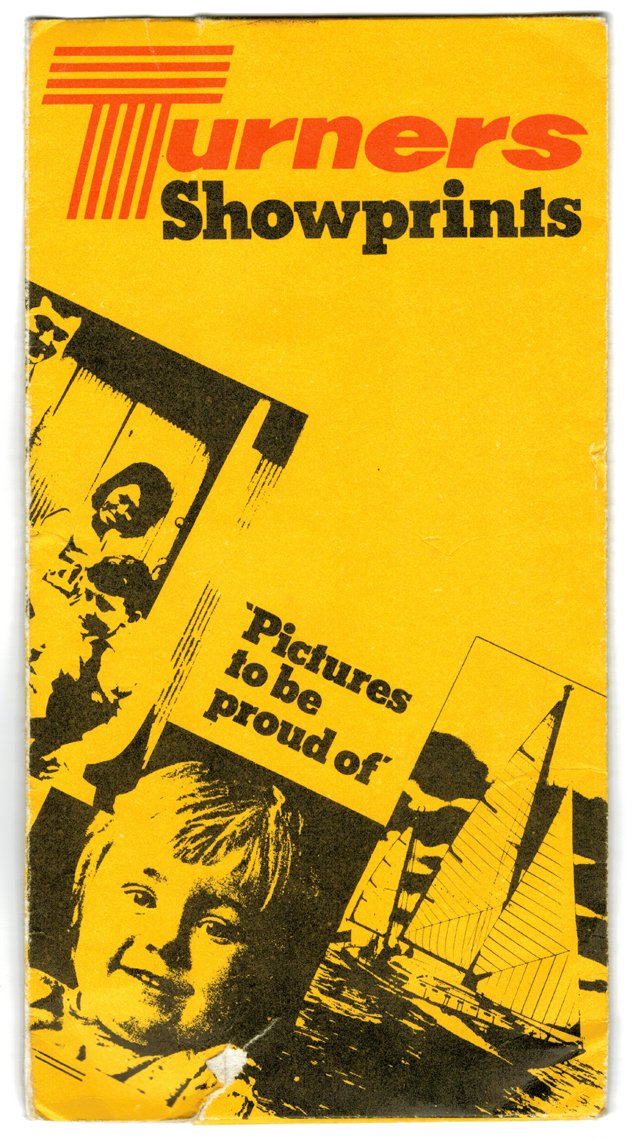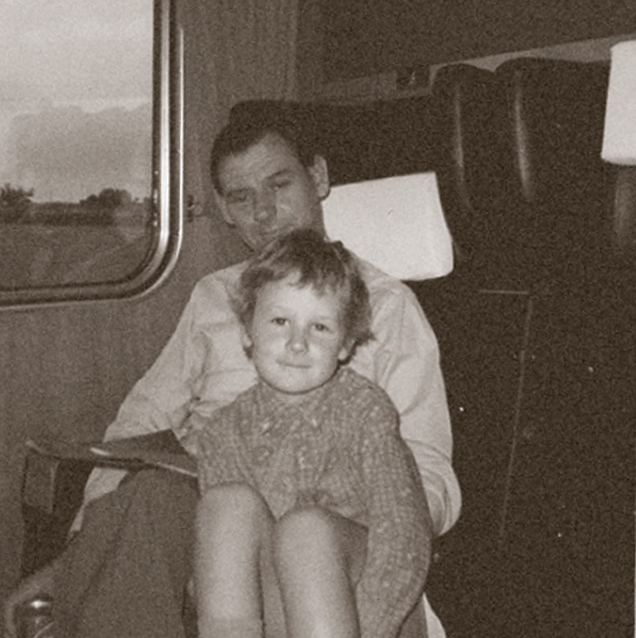I think it’s the scarcity of my childhood photographs that gives them such potency. I’d estimate that, during the first eighteen years of my life, fewer than 100 photographs were taken of me… and the family camera was seen almost as a sacred object: brought out of its leather case for daytrips or family occasions, but otherwise kept hidden in a musty nook of the sideboard, nestling between unopened bottles of Campari and Warninks Advocaat, all gathering dust and – like me – counting down the interminable, slow-moving days until Christmas.
The process of developing photos was slow and laborious, too… there was the endless wait to “finish the film” before it was packed into an envelope and sent away – with an accompanying cheque – to Truprint or Turners: mysterious-sounding companies in secret laboratories that my fevered imagination transformed into the photographic equivalent of Willy Wonka’s Chocolate Factory. Weeks would then pass before we could finally discover whether that picture of my Grandma feeding the giraffes at Flamingo Land had actually “come out”, or whether my clumsy thumbs had decapitated the entire family once again.

Photographs became forgotten objects, rarely shared… filed away in gaudy envelopes with their accompanying negatives in a secret pouch, or stuck carefully into musty, brown-card albums and relegated to bedroom cupboards. They physically faded, too… stark monochrome images became fuzzy grey shadows, and vibrant 1970s colours melded into the uniform orange and brown wash that has come to epitomise my memories of the decade. And yet this paucity, and this degradation, has lent our surviving childhood photos such extroardinary power. Fragments of frozen moments and long-lost loved ones, preserved in attics and chests of drawers, may be frequently unseen… but they are never unloved.
These feelings have inspired the new album from Jonathan Sharp, founder of The Heartwood Institute, and purveyor of “Hauntronica from the Heart of the English Lake District”. Previous Heartwood Institute releases – including the superb Secret Rites – have taken inspiration from the stories and landscape of his native Cumbria, but the new album Divided Time, released under Jonathan’s own name, does so in a way that feels more intensely personal, inspired directly by an album of evocative childhood photographs discovered amongst his mother’s belongings.

The album is a beautiful collection of elegaic piano-led pieces, each taking direct inspiration from individual photographs of Jonathan and his family taken in a period spanning 1970-1977; largely capturing the lakes, hills and seaside towns of his native county, but also peppered with intriguing detours to cosmopolitian Kensington and Battersea, and excursions to Hyde Park. There are woozy synths and plaintive glockenspiels that occasionally – for this listener, at least – conjure up memories of school music lessons. I asked Jonathan about the stories behind Divided Time, and his memories of the photographs that influenced the music…
Bob: How and where did you find the photos? Had they been hidden away for a long time?
Jonathan: I found them about twelve months ago. I knew my mother had lots of albums and I was really curious to go digging and see what was there. So they weren’t hidden… more like forgotten.
Do you have specific memories of any of them actually being taken?
It’s a long time ago, but some of them… yes, I clearly remember them being taken. With others, not so much – it’s more of a case of remembering the place, if not the time. Or they’ll bring back related memories.

I imagine they evoked particularly special memories of your parents…
Lots and lots of very happy memories. I had a very happy childhood.
They brought back memories of how different the world was back then… of trains having compartments. I clearly remember the flat in Drayson Mews, Kensington like it was yesterday, and it’s the same for the photos of the Steam Gathering in Kendal.
But sure, lots of memories of my parents too – my father died some time ago, and my mother isn’t in the best of health right now. The photo of Silloth, that’s me with my grandmother and her sister. So I’ve tried to include as much of my family as possible, that seemed really important to the whole project.

There’s a lovely sense of place to some of these photos, particularly the pictures taken in Cumbria. Were visits to places like Bassenthwaite and Silloth a big part of your childhood? Can you talk us through some of the locations that inspired the album?
Sure… the opening track is inspired by a really early photo from 1970 of me looking at Castlerigg Stone Circle, a place that I’ve just kept going back to over the years. I actually have no memory of that photo, so I was surprised to find I’d been there as such a small child. Maybe that’s where my obsession with the place started.
Silloth… oh yes, the place to be as a kid. It’s an Edwardian seaside retreat that hasn’t aged well, but as a kid there was a penny arcade and donkey rides… imagine a scaled-down Morecambe or Blackpool and you’re there. Going to Silloth was a real treat. Bassenthwaite too, that was somewhere we went often, just to walk around… it’s the closest Lake. That particular photo brings back memories of an incredibly bitter winter when the lake actually froze over.
And there’s a whole batch of photos from London in 1974 and 1975, some of which I actually took myself. Those will be the wonky out of focus ones!

Where’s Cherry Woods? That’s a very evocative name.
It’s a wood close to where I grew up in Cumbria, but it’s not on any map under that name. I think that’s just what we called it… or how it had always been known to my parents’ generation. But obviously, in the world of Google Maps, it doesn’t exist under that name. Which says a lot about how digitalisation has reshaped our lives.

For a kid growing up in Cumbria, you seemed to spend a lot of time in London in the mid-1970s. Did you have family there?
Well, I should explain… my father lived and worked in London, and my mother lived in Cumbria. So for most of our holidays we’d go to London. So yes, I spent quite a bit of time there in the 1970s, and then again in the 1980s. We’d go where he was working, so I also spent some time in New York in the late 1970s… but that’s for the next album!
For someone from a very rural background, London was just an incredible, eye-opening experience. I think I was incredibly lucky to be exposed to such a vibrant, multi-cultural experience at such a young age. There was certainly a sense of wonder… even at something as simple as a black cab or a steakhouse, these things just didn’t exist in Cumbria back then. It may sound mind-boggling, but… pizza! Pizza just was not something you could get in Cumbria, and I clearly remember thinking that I was being so exotic and grown-up, eating my first pizza in London.
It’s funny, but my other abiding memory of London is the security. This was prime IRA bombing time, and I clearly remember being searched when I was going into museums and theatres. That, and the sheer number of Hare Krishnas in robes! It’s funny what sticks in your mind.

A huge element of my childhood nostalgia is that so little of my childhood was “recorded”… I reckon there are fewer than 100 photos of me from the first 18 years of my life, and there’s no moving footage at all. Do you have similar feelings? Does this give nostalgia from the “pre-digital” era a real sense of yearning?
It’s absolutely the same for me. Maybe there are more than a hundred photos of me, as both my parents were into photography, but there are no moving images of me from that period. It’s the nature of the format as well… Polaroids, and photos that have degraded over time. I think that “fuzziness” contributes to the nostalgia factor too. Honestly, it’s like looking through a slightly oblique window into a different world. And really, it was a completely different world in so many ways.
How did you go about emulating the feel of the photos with the music on the album? Were there specific sounds, musical textures, even instruments that seemed to capture the feel of different photos? There seems to be a bit of glockenspiel on there, which reminded me of school music lessons!
Ha, school music lessons… you know, I think there was a certain element of that, at a subconscious level. I was certainly exposed to music at a very young age, I started piano lessons at about six or seven, and I also remember those “Music and Movement” sessions at junior school. I always liked the ones where the instruments came out… things like glocks and mini xylophone.
Probably 90% of these tracks started out as piano sketches, so there are a lot of different kinds of pianos deployed, from jazzy electric Rhodes and classical piano through to Hauschka influences… broken and prepared pianos. I find piano a very expressive instrument. And then the images themselves tended to suggest a tonal palette… be it synths, orchestral elements or more glitchy abstract sounds.
I’ve had a few people comment on how sad the overall feel is, which is a surprise to me as that’s not the vibe I was going for, I was aiming for more a kind of warm, fuzzy, slightly degraded vibe. A personal hauntology, if you like!

Divided Time is released on 21st June on limited edition vinyl, and via download, from the excellent, and prolific, Castles In Space label. It can already be pre-ordered here…
https://jonathansharp-cis.bandcamp.com/album/divided-time
Jonathan Sharp is @Doctorninesharp on Twitter, and you can follow The Heartwood Insitute @Heartwood9. Castles in Space is @CastlesInSpace. Thanks to Jonathan and to Colin Morrison from Castles in Space… and Divided Time will also be featured in the next Haunted Generation column to be included in the Fortean Times magazine, available on 20th June.
You had me at Campari. Not that we ever had any in the house, I just remember it from ubiquitous full page colour adverts in the Sunday supplements. That and John Player Specials.
LikeLiked by 1 person
I love Campari. It tastes like old wardrobes.
LikeLike